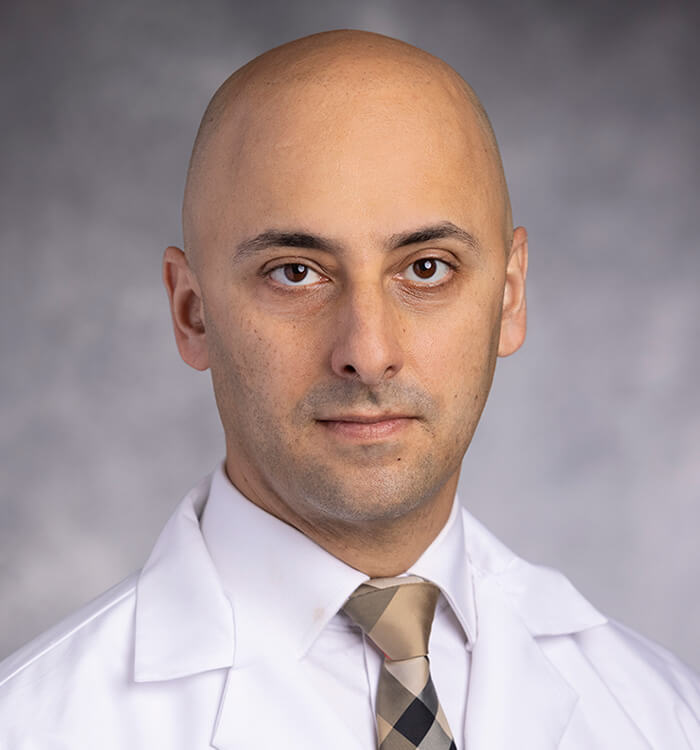Leading the Way in ENT Neurostimulation
February 20, 2024
Innovations in Ear, Nose & Throat | Winter 2024
Physician-scientists within the University Hospitals Ear, Nose & Throat Institute are utilizing leading neurostimulation techniques to advance patient care. Precise targeting of nerves within the head and neck provides novel treatment options to address sleep apnea, hearing loss and more.
 Thomaz Fleury Curado, MD, PhD
Thomaz Fleury Curado, MD, PhDThe Future of Neurostimulation for Sleep Apnea
Implantable hypoglossal neurostimulation (HGNS) has been available to treat moderate to severe obstructive sleep apnea (OSA) for the past decade.
“Sleep apnea is a prime condition for neurostimulation because the underlying cause is often lack of input,” says Thomaz Fleury Curado, MD, PhD, an otolaryngologist and craniofacial surgeon within the UH Ear, Nose & Throat Institute. “We have the research to show that muscle tone declines with age, creating a lack of input sufficient to keep the airway open.”
University Hospitals was among the first health systems in the country to offer Inspire® Upper Airway Stimulation following its approval by the U.S. Food and Drug Administration (FDA) in 2014. An alternative to continuous positive airway pressure (CPAP), Inspire combines an implantable pressure-sensing lead and a stimulating lead to generate gentle pulses that position the tongue to improve airway patency.
Now, the next generation of HGNS is under investigation. University Hospitals is the only health system in Northeast Ohio participating in the OSPREY randomized clinical trial of LivaNova’s aura6000™ system, designed to stimulate both protruders and retractors at multiple points along the tongue. “With Inspire, we see robust movement to stimulate tongue protrusion,” says Dr. Fleury. “In contrast, the LivaNova technology seeks to improve tone, stiffening the tongue to clear the airway.”
He notes other key differences. LivaNova involves a less invasive implantation procedure because the system does not require placement of a sensing lead or complex dissection of the hypoglossal nerve. Instead of synchronizing HGNS with respiration, the aura6000 bursts rhythmically throughout the breathing cycle. Additionally, LivaNova does not require a drug-induced sleep endoscopy to exclude complete concentric airway collapse. “Because this technology works a bit differently, the type of collapse might not affect its efficacy,” Dr. Fleury says.
Recently published early results from OSPREY find aura6000 safe and with similar effectiveness as current treatment. “Now, the study’s focus is on implanting additional patients to confirm findings prior to filing for FDA approval,” he says.
Looking ahead, Dr. Fleury sees neurostimulation’s potential for personalized, targeted therapy. “If we know we can stimulate the tongue, how about other muscles in the airway?” he says. “I think the future will involve differentiated types of stimulus delivery tailored to individual phenotypes. We are a few years away, but that is where the research is leading.”
Leading the Way in Cochlear Implantation
 Alejandro Rivas, MD
Alejandro Rivas, MDThe University Hospitals Cochlear Implant Center of Excellence is one of the largest programs in the U.S., offering multidisciplinary expertise for individuals with moderate to profound deafness. An approved treatment method for over four decades, cochlear implantation is an early example of neurostimulation.
Cochlear implants bypass damaged hair cells, delivering rich impulses via an electrode placed in direct contact with auditory neurons. “Cochlear implants were initially indicated for complete deafness in both ears,” says Alejandro Rivas, MD, Division Chief of Otology and Neurotology, Director of the UH Cochlear Implant Center, and Professor of of Otolaryngology-Head and Neck Surgery and Neurological Surgery at Case Western Reserve University School of Medicine. “What we have identified more recently is that these prostheses are also highly effective for patients with residual hearing or single-sided deafness.”
Dr. Rivas explains that many children and adults with partial hearing lack the ability to understand speech and communicate effectively. “It’s like having a bad cell phone connection; you can hear sounds but not comprehend a conversation,” he says. “More and more, we are able to use cochlear implants to improve speech understanding for these patients.” For example, an individual with 60 percent speech understanding can potentially improve to 90 percent or higher with cochlear implantation and audiology training.
Patients with single-sided deafness are also able to benefit from cochlear implants. “We do not live in a quiet world, and individuals with deafness in one ear cannot understand speech in noisy environments or perceive where sounds are coming from,” Dr. Rivas says. “We know that patients with single-sided hearing can experience superior outcomes with cochlear implants compared to hearing aids.”
Current clinical trials continue to focus on the benefits of cochlear implants in patients with varying levels of residual hearing. Additionally, the potential for neurostimulation to impact ENT is expanding into novel treatment modalities.
“ENT deals with organs of the senses, which tend to decrease over time,” Dr. Rivas says. “As the population ages, the beauty of neurostimulation is its ability to provide solutions that retain the hearing you still have while restoring the sensory perception that you have lost.”
For more information about the University Hospitals ENT Institute and its expert providers, please call (440) 837-3263.
Contributing Experts:
Thomaz Fleury Curado, MD, PhD
Ear, Nose & Throat Institute and
University Hospitals Cleveland Medical Center
Assistant Professor
Department of Otolaryngology-Head and Neck Surgery
Case Western Reserve University School of Medicine
Alejandro Rivas, MD
Division Chief, Otology and Neurotology
Director, Cochlear Implant Center
Richard R. and Patricia W. Pogue Chair in Auditory Surgery and Hearing Sciences
University Hospitals Cleveland Medical Center
Professor of Otolaryngology-Head & Neck Surgery and Neurological Surgery
Case Western Reserve University School of Medicine


